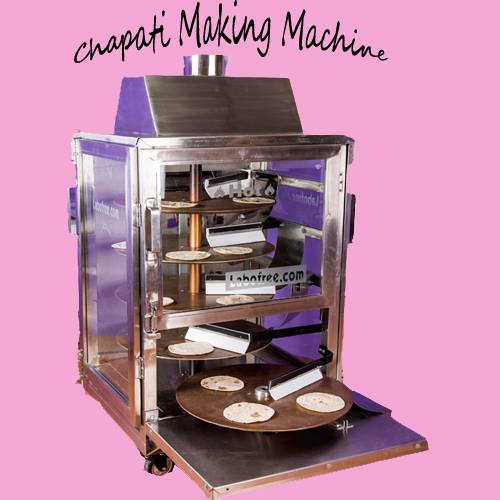If you are running a restaurant, cafeteria or any food business that serves chapati, puri or any wheat flour-based flatbread, then a commercial roti pressing machine can be your ultimate solution for efficient and productive chapati making. With the help of a commercial roti pressing machine, you can produce a large number of chapatis or puris in less time, without compromising on quality or consistency. In this article, we will discuss the importance of a commercial roti pressing machine in detail and how it can enhance your chapatti-making process.
How a Commercial Roti Pressing Machine Works
A commercial roti pressing machine is designed to automate the process of making chapatis or puris. The machine consists of two heated plates, which are used to press the dough and create flatbreads of a uniform thickness.
The dough is placed between the two plates, and the plates are pressed together using a motor and heavy-duty gearbox. The pressing plates are coated with Teflon, a food-grade material that prevents the dough from sticking to the plates. The machine has a digital control panel that allows you to adjust the thickness of the flatbreads according to your requirement.
Efficiency and Productivity
The roti making machine is a high-capacity appliance suitable for commercial kitchens, producing 500-700 chapatis or puris per hour. The machine ensures consistent quality by producing uniformly sized chapatis with a diameter of 5-8 inches and a thickness of 1.5-2.5mm. The Teflon-coated aluminum plates and metal plates covered with SS 304 covers prevent sticking, making the rolling process efficient. The 5 hp motor, heavy-duty gearbox, and ceramic heaters heat and roll the dough fast and efficiently.
The digital control panel and sturdy parts make the machine easy to operate and maintain. The machine’s compact size of 22” X 22” X H 54” and a weight of 90kg make it easy to install and move around. The machine’s durable structure, made of high-quality materials, such as MS angels powder-coated body sheet covers and SS 304 grade covers, ensures longevity.
Technical Details of Commercial Roti Pressing Machine
Capacity: 500-700 per hr raw Chapatis or puris of wheat flour |
Size of chapati: 5” to 8” dia. approx |
Thickness of Chapati: 1.5 to 2.5 mm. |
Chapati press plates: 4mm thick aluminum Teflon coated (du-pont food grade coating) plates supported with 22mm metal plates covered with SS 304 covers |
Motors: 5 hp motor & heavy duty gearbox (make crompton greaves) |
Heating System: Chapati rolling press is heaving 1.5 K watt X 2 no. heaters (Ceramic) |
Control Panels: Digital panel with all heavy duty parts . |
Energy Consumption: Electrical heaters & motor consumes 3.5 KW (3 to 4 units per hour)approx (power supply 220 volt(single/three phase)) |
Machine Size: 22” X 22” X H 54”, Wt. 90 KG (approx.) |
Body & Structure: Main Frame of ms angels powder coated body sheet covers 1.2 -1.5 mm thick SS 304 grade & all engineering parts EN series hardened (Chrome plated) |
Packing: Wooden box 26″ * 30″ * 60″ inches wt 140kg |
Process: After feeling Peda (round ball of dough) round chapati will come out with-in seconds(without sticking) |
Note: Tawa systems(hot plate) with puffer plate are available on extra cost(LPG based) |
Benefits of Using Commercial Roti Pressing Machine
The roti making machine is a highly productive appliance suitable for commercial kitchens, producing 500-700 raw chapatis or puris per hour. The machine’s Teflon-coated aluminum plates ensure consistent size and thickness, resulting in high-quality output ranging from 5” to 8” in diameter and 1.5 to 2.5 mm in thickness.
It is also durable and long-lasting, featuring a 5 hp motor and heavy-duty gearbox from Crompton Greaves, allowing for continuous use without any downtime.
Furthermore, the roti making machine is highly energy-efficient, requiring only 3.5 KW (3 to 4 units per hour) of electricity to operate the electrical heaters and motor. Its digital control panel and ceramic heaters make it easy to operate, leading to consistent and high-quality production. With a compact size of 22” x 22” x H 54” and weight of 90 kg, it is also easy to transport.
Frequently Asked Questions
What is the capacity of the roti making machine?
The machine has a capacity of producing 500-700 raw chapatis per hour.
What is the size and thickness of the chapatis produced by the machine?
The chapatis produced by the machine are of consistent size and thickness, ranging from 5” to 8” in diameter and 1.5 to 2.5 mm in thickness.
How much electricity is required to operate the machine?
The roti making machine is highly efficient, with only 3.5 KW (3 to 4 units per hour) of electricity required to operate the electrical heaters and motor.
Is the machine easy to maintain?
Yes, the machine’s sturdy construction with the main frame of MS angels powder-coated body sheet covers, 1.2-1.5 mm thick SS 304 grade, and all engineering parts EN series hardened (Chrome plated) ensures that it is easy to clean and maintain.
Can the machine produce puris as well?
Yes, the machine can produce puris made of wheat flour as well.
What is the weight and size of the machine?
The machine has a weight of 90 kg and a compact size of 22” x 22” x H 54”, making it easy to store and transport
Does the machine come with a warranty?
Yes, the machine comes with a one-year warranty for any manufacturing defects.
Conclusion
The roti making machine offers several benefits and features, including high production capacity, consistent size and thickness, durability, energy efficiency, ease of operation, compact size, easy transport, easy maintenance, and additional options for increased production capacity. It is a must-have appliance for commercial kitchens that require large quantities of fresh chapatis or puris.


